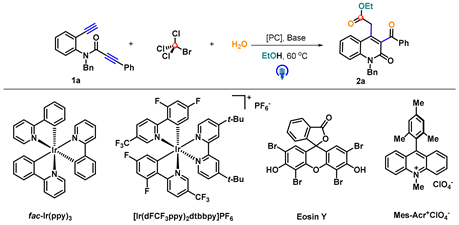Abstract
We present the first example of visible-light-mediated multicomponent annulation of 1,7-diynes by taking advantage of quadruple cleavage olf carbon-halogen bonds of BrCCl3 to generate a C1 synthon, which was adeptly applied to the preparation of skeletally diverse 3-benzoyl-quinolin-2(1H)-one acetates in moderate to good yields. Controlled experiments demonstrated that H2O acted as both oxygen and hydrogen sources, and gem-dichlorovinyl carbonyl compound exhibited as a critical intermediate in this process. The mechanistic pathway involves Kharasch-type addition/6-exo-dig cyclization/1,5-(SN”)-substitution/elimination/binucleophilic 1,6-addition/proton transfer/tautomerization sequence.
1. Introduction
C1 chemistry has emerged as a flourishing approach for the formation of homologous compounds, which introduced an additional carbon atom into the substrates to assemble valuable molecular frameworks [1,2,3]. C1 chemistry has gained significant attention in the field of organic synthesis due to its ability to increase the length of carbon chains [4] and construct important functional groups (e.g., carboxylic or carbonyl groups) [5], which was utilized in the modification of pharmaceuticals, agrochemicals and bioactive natural products for value addition [6,7]. As we all know, CO2, CO and HCOOH are useful one-carbon building moiety, which have been widely exploited in many interesting and unprecedented transformations [8]. In the past few years, Song and coworkers discovered that several readily available halodifluoroalkyl compounds, including BrCF2COOEt, ClCF2COONa and ClCF2H, could act as a C1 precursor via the activation of two aliphatic C–F bonds along with the cleavage of C-X (X = Cl, Br or I) and C-R bonds, that is, a quadruple cleavage on one molecule in one pot [9,10,11,12,13].
Compared with halodifluoromethyl reagents [14], CBrCl3 or CBr4 is also widely pursued as a catalyst, reagent, and mediator for the preparation of polyhalogenated compounds in various organic transformations [15,16]. Among them, these tetrahalomethanes can undergo homolytic cleavage to deliver a bromine radical and a trihalomethyl radical by using visible light irradiation, which provides a green and efficient method for preparing important gem-dihaloalkene scaffolds through double cleavage of C-Br and C-X (X = Cl, Br) bonds (Scheme 1a, path I) [17,18,19,20]. In contrast to the well-developed methodology for building up gem-dihaloalkenes by means of tetrahalomethanes as radical precursor, investigations on bromotrichloromethane serving as C1 sources via quadruple cleavage are considerably less common (Scheme 1a, path II). For this reason, developing new, practical and sustainable photocatalytic methods that enables the direct deconstruction of tetrahalomethanes to add one extra carbon into functionalized organic molecules remains a formidable challenge, which might have deep impact on C1 chemistry as well.

Scheme 1.
Different cleavages of perhalogenated methanes.
Visible light-induced photoredox catalysis (VLPC) has been confirmed as one of the most attractive and powerful protocols for initiating various radical chemistry to construct a plethora of complex organic molecules because of its intrinsic characteristics of greenness, availability, safety as well as sustainability [21,22,23,24,25,26,27,28]. This type of reaction provides a unique and direct way to construct intricate architectures that cannot be obtained by thermal processes [29,30,31,32,33,34,35]. In particular, photocatalytic annulation cascade reactions of 1,n-diynes appear as a remarkable and applicable platform for facilitating the formation of poly-substituted isocyclic and heterocyclic compounds via synergistic interactions across their two unsaturated carbon–carbon triple bond [36,37,38]. Furthermore, Kharasch-type addition/cyclization of unsaturated systems by taking advantage of photocatalytic strategy is a convenient and atom economy method for producing polyhalogenated products [39,40,41,42,43]. For instance, the group of Jiang elaborated a photocatalytic three-component biheterocyclization of heteroatom-linked 1,7-diynes with CBrCl3 and water, leading to access skeletally diverse fused-tricyclic heterocycles [38]. Encouraged by previous results and the continuation of our interest in synthetic chemistry [44,45,46,47], we planned and conceived that the reaction can be directed toward photoinduced addition-annulation to build up quinolone skeletons when secondary alcohol-tethered 1,7-diynes was changed by amide-anchored 1,7-diynes as radical receptors. Intriguingly, we found the multicomponent cyclization reaction of amide-anchored 1,7-diynes 1 with CBrCl3, H2O and alcohols/thiols under visible-light irradiation, producing a plethora of 3-benzoyl-quinolin-2(1H)-one acetates 2 in moderate to excellent yields (Scheme 1b). During this protocol, CBrCl3 serves as a C1 source by fully breaking one C–Br bond and three C–Cl bonds, and H2O acted as both oxygen and hydrogen sources in a single pot. To the best of our knowledge, this Kharasch-type multicomponent-annulation of amide-anchored 1,7-diynes via deconstruction of bromotrichloromethane remains unprecedented so far. Herein, we document these attractive transformations.
2. Results and Discussion
At the beginning, N-benzyl-N-(2-ethynylphenyl)-3-phenylpropiolamide (1a) and CBrCl3 were selected as the model substrates to establish reaction conditions, and the detailed results are shown in Table 1. The reaction of 1a with CBrCl3 was irradiated under 30 W blue LEDs in the presence of fac-Ir(ppy)3 as photocatalyst in EtOH and H2O (v/v, 100:1) as co-solvent at 60 °C. The reaction proceeded poorly, and unexpected 3-benzoyl-quinolin-2(1H)-one acetate 2a was observed in 48% yield after 36 h (Table 1, entry 1). The yield of product 2a was increased to 67% in the presence of K2CO3 as base (Table 1, entry 2). Reducing reaction time will not improve the conversion of this transformation, as there is a large amount of starting material remaining (Table 1, entry 3). On the contrary, increasing reaction time led to reduced yields, but no side products were separated (Table 1, entry 4). The generation of 2a was seriously inhibited in the absence of the fac-Ir(ppy)3 catalyst (Table 1, entry 5), suggesting that photocatalyst plays an important role in this process. Next, we examined other photocatalysts including [Ir(dFCF3ppy)2dtbbpy]PF6, Mes-Acr+ClO4− and Eosin Y, and found that all of them exhibited poorer catalytic performance than that of fac-Ir(ppy)3 with respect to the yield of 2a (Table 1, entries 6 and 8). Replacing K2CO3 as other inorganic bases including Na2CO3, Cs2CO3 and MeONa did not have any favorable impact on this reaction (entries 9–11). Similarly, Et3N and 4-dimethylaminopyridine (DMAP) as organic base also resulted in lower yields compared to that of K2CO3 (entries 12–13 vs. entry 2). Moreover, increasing or decreasing the amount of H2O in the co-solvent could not promote the efficiency of the multi-component reaction (entries 14–15). Finally, the use of CBr4 as a Cl precursor to replace CBrCl3 under standard conditions enabled a similar process to give rise to product 2a, but with a significant drop in the yield (Table 1, entry 16).

Table 1.
Optimization of reaction conditions for 2a a.
Having established the optimal reaction conditions, we then evaluated the substrate scope and generality of various amide-linked 1,7-diynes and alcohols for this photocatalytic multicomponent deconstruction of CBrCl3, and the results are summarized in Scheme 2. Firstly, ethanol as nucleophilic reagent reacted with 1,7-diynes 1 to investigate the influence of electronic properties and positions of substituents in the arylalkynyl units (R1), and all of them conveniently participated in the current multicomponent cyclization with acceptable yields. Both electron-donating (such as methyl 1b and 1c, methoxy 1d, and tert-butyl 1e) and electron-withdrawing (fluoro 1f) groups located at the meta- or para-position of the arylalkynyl moiety can all work well in this system, affording the corresponding quinolin-2(1H)-ones 2b–2f in 49–65% yields. However, the obvious impact on steric hindrance and electronic effect were demonstrated because arylalkynyl with ortho substituted (o-Me, o-Cl) or strong electron withdrawing groups (p-Br, p-CO2Me) inhibited the progress of the reaction, delivering nearly no desired product. Next, 1,7-diynes with different benzyl groups at the nitrogen atom have been proved to be suitable reaction partners under standard condition. The benzyl group bearing a functional group, such as ether (o-methoxy 1g), alkyl (p-methyl 1j) and halogen (m-fluoro 1h, m-chloro 1i, p-fluoro 1k, p-chloro 1l, p-bromo 1m) proceeded smoothly, enabling their addition-cyclization to render the desired products 2g–2m with yields ranging from 47 to 69%. Subsequently, we chose methyl (1n and 1o) as the representative functional group to introduce C4 or C5 position of the internal arene ring of diynes to investigate its synthetic utility. The corresponding 3-benzoyl-quinolin-2(1H)-one acetates were isolated in 55% and 60% yields, respectively.
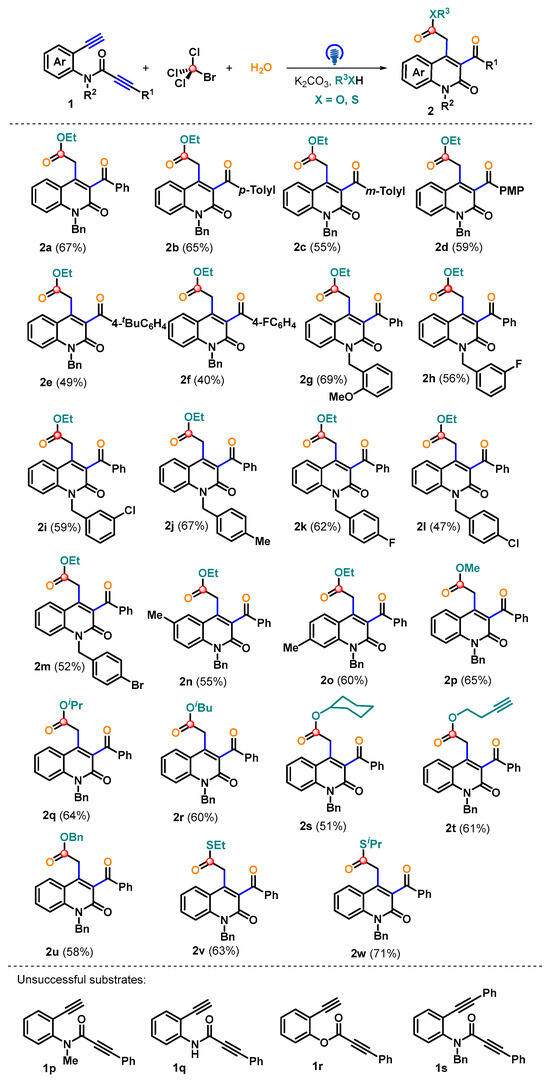
Scheme 2.
Substrate scope for forming products 2. Reaction conditions: 1 (0.2 mmol), CBrCl3 (0.4 mmol), fac-Ir(ppy)3 (1 mol%), K2CO3 (2.0 equiv.), alcohols (thiols)/H2O (2.0 mL, 100:1 v/v), under 30 W blue LEDs irradiation, at 60 °C in oil bath, under Ar atmosphere for 36 h. Isolated yield based on 1.
We next devoted our effort to explore the scope of this radical-triggered multicomponent annulation by taking advantage of different alcohols as nucleophiles. The compound 1,7-diynes 1a was subjected to the treatment of various alcohols consisting of linear (methyl, but-3-yn-1-yl, benzyl), branched (isopropyl, isobutyl) and cyclic (cyclohexyl), which were proven to be applicable for this method, as targets 2p–2u were generated in 51–65% yields. Promisingly, both ethanethiol and propane-2-thiol are good candidates, providing the quinolones-containing ethanethioate 2v–2x in 63% and 71% yields, respectively. It is interesting and unexpected that thiols act as nucleophilic reagents and solvents, rather than as radical donors [48,49]. Unfortunately, N-Me protected 1p or N-unprotected amide-linked 1,7-diyne 1q and ester linked 1,7-diyne 1r were not effective reaction partners, as they were unsuccessfully transformed into corresponding products. Furthermore, the preformed substrate 1s with two internal alkyne moieties was examined, but the reaction did not proceed under this catalytic system and 1,7-diyne 1s was recovered, showing that terminal alkynes on starting material play an important role for this transformation.
The gram-scale experiments for preparation of 2a on a 4.0 mmol scale were conducted under optimal conditions, and the product was delivered with a comparable yield (60%, Scheme 3a). Then, the practicality of this approach was further studied by the late-stage functionalization of products. For example, the treatment of 2a with hydrazine hydrate in EtOH by using HOAc as acid, resulting in 3-amino-6-benzyl-4-phenylbenzo[c][2,7]naphthyridine-2,5(3H,6H)-dione 3 in 82% yield (Scheme 3b).
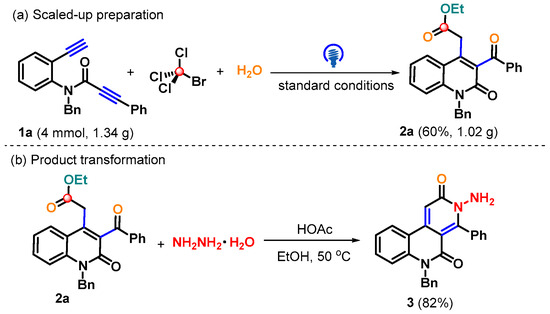
Scheme 3.
Scaled-up preparation and product transformation.
Several control experiments were performed to gain mechanistic insight into the reaction pathway. Firstly, the use of a radical inhibitor TEMPO (2,2,6,6-tetramethyl-1-piperidinyloxy) successfully suppressed the reaction process, and the result confirmed that a trichloromethyl radical may be involved in these transformations (Scheme 4a). When a 4 Å molecular sieve was employed as dehydrating agent and dry EtOH as solvent under standard conditions, the reaction process was completely inhibited (Scheme 4b). In addition, the reaction was carried out in the presence of H218O (98 atom% 18O), and the products 2a and 2a-O18 were identified by HR-MS in a 3:1 ratio (Scheme 4c). These two survey results indicated that the oxygen source of the ester and carbonyl group in target products come from water. The deuterium-labeling experiment was performed to confirm the hydrogen source of methylene. In the presence of D2O, the deuterated product [D]-2a was obtained with the percentage content of deuterium being 69% (Scheme 4d). The reaction between 1a with CBrCl3 in wet-acetonitrile at room temperature in the presence of K3PO4 as base, which underwent Kharasch addition/1,5-(SN″)-substitution cascade process to form gem-dichlorovinyl carbonyls product 4 with 37% yield, followed by reaction with EtOH and H2O (v/v, 100:1) at 60 °C for 36 h, leading to the desired product 2a in 75% yield. These observations suggest that gem-dichlorovinyl may serve as a key intermediate for the generation of product 2 (Scheme 4e,f). Finally, several fluorescence quenching experiments indicated that CBrCl3 was a more efficient quencher of the excited state of fac-Ir(ppy)3* than 1,7-diyne 1a (Figure 1, see the Supplementary Materials for details).
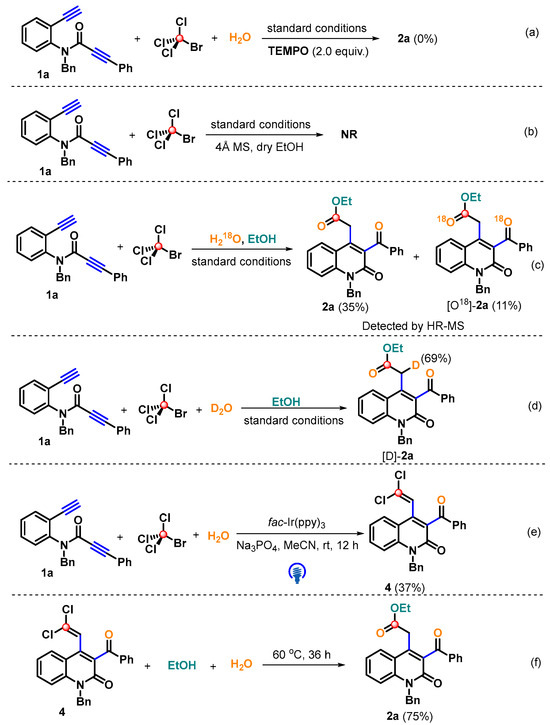
Scheme 4.
Mechanistic experiments (a–f).

Figure 1.
Stern–Volmer analysis for fac-Ir(ppy)3 with 1a and CBrCl3.
Combined with these experimental outcomes and previous related works [17,18,19,20], we proposed a plausible mechanism about this photoredox-catalyzed multicomponent annulation of 1,7-diynes. As shown in Scheme 5, the photocatalytic cycle was initiated by the activation of Ir(III) with blue light irradiation to form the excited state Ir(III)* species, which reacts with BrCCl3 to yield trichloromethyl radical A and a bromine anion, together with Ir(IV) complex via a single electron transfer (SET). Next, the radicals A can be trapped by the terminal carbon–-carbon triple bond of 1,7-diyne 1a to provide the alkenyl radical B, which undergoes 6-exo-dig-cyclization to give intermediate C. The resulting bromine anion was oxidized by Ir(IV) complex to produce Br radical [50,51], followed by radical cross coupling with C to obtain intermediate D and to regenerate Ir(III) species. Subsequently, the intermediate D reacts with OH− from H2O to afford the intermediate E through 1,5-(SN″)-substitution, which eliminates one molecule of HBr to assemble a key intermediate 4. The intermolecular 1,6-addition of hydroxyl anion into intermediate 4 gives intermediate F, followed by protonation and removal of HCl to furnish intermediate H, which then undergoes nucleophilic 1,6-addition with ethanol, following by proton transfer (P.T.) and removal of HCl to generate intermediate K. Finally, the intermediate K transforms into the desired products 2a through tautomerization.
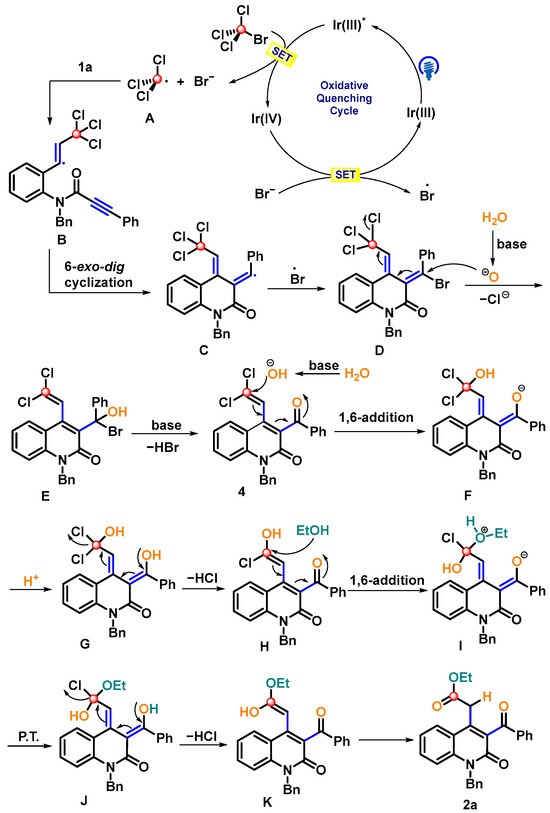
Scheme 5.
Proposed pathway toward product 2a.
3. Materials and Methods
General procedure for the synthesis of compounds 2
Example for the synthesis of 2a:
In a 25-mL Schlenk tube, 1,7-diyne 1a (0.2 mmol, 67.0 mg, 1.0 equiv), BrCCl3 (0.4 mmol, 79.2 mg, 2.0 equiv), K2CO3 (0.4 mmol, 55.2 mg, 2.0 equiv), fac-Ir(ppy)3 (1.3 mg, 1 mol%) and EtOH/H2O (2.0 mL, 100:1 v/v) were successively added under Ar conditions. Then, the tube was stirred at 60 °C in oil bath for 36 h under 30 W blue light (blue LEDs) irradiation until complete consumption of 1a as monitored by TLC analysis. After the reaction was completed, the reaction mixture was concentrated in vacuum and the resulting residue was purified by column chromatography on silica gel (eluent, petroleum ether/ethyl acetate = 10:1) to afford the desired product 2a (57.0 mg, 67%) as a white solid.
General procedure for the synthesis of compounds 3
To compound 2a (0.1 mmol, 42.5 mg) a solution of hydrazine hydrate (0.5 mL) and acetic acid (one drop) in 1.0 mL EtOH was added and the mixture was stirred at 50 °C for 2 h until TLC analysis showed that 2a was completely consumed. The reaction mixture was then diluted with water, extracted with ethyl acetate, washed with water until neutral, and concentrated the organic layer under reduced pressure. The residue was purified through preparative thin layer chromatography (petroleum ether/ethyl acetate = 1:1 v/v) to afford compound 3 as white solid.
General procedure for the synthesis of compounds 4
In a 10-mL Schlenk tube, 1,7-diyne 1a (0.1 mmol, 33.5 mg, 1.0 equiv), BrCCl3 (0.2 mmol, 39.6 mg, 2.0 equiv), Na3PO4 (0.2 mmol, 32.8 mg, 2.0 equiv), fac-Ir(ppy)3 (0.6 mg, 1 mol%) and MeCN (1.0 mL) were successively added under Ar conditions. Then, the tube was stirred at room temperature for 12 h under 30 W blue light (blue LEDs) irradiation until complete consumption of 1a as monitored by TLC analysis. After the reaction was completed, the reaction mixture was concentrated in vacuum and the resulting residue was purified by column chromatography on silica gel (eluent, petroleum ether/ethyl acetate = 15:1) to afford the desired product 4 (16.0 mg, 37%) as a white solid.
4. Conclusions
In summary, starting from easily prepared amide-anchored 1,7-diynes and available BrCCl3, we have discovered a novel photocatalytic carbon–halogen full bond breaking strategy of bromotrichloromethane for the straightforward generation of a series of 3-benzoyl-quinolin-2(1H)-one acetates with acceptable yields. The further transformation of these resultant 1,5-dicarbonyls into 6/6/6 nitrogen-containing tricyclic skeleton demonstrates more opportunities for applying this policy to polycyclic molecules. This four-component reaction features bond-forming efficiency, broad functional group compatibility and mild reaction conditions. Despite great progress made in this reaction, there are still disadvantages of this synthetic method, such as long reaction time, low atomic economy and cannot be used for late-stage modification of pharmaceutical compounds. Further research of this amide-linked 1,7-diyne is currently being conducted in our group.
Supplementary Materials
The following supporting information can be downloaded at: https://www.mdpi.com/article/10.3390/molecules29040782/s1, Figures S1 and S2: Luminescence Quenching Experiment; Figure S3: Control Experiment with H218O; Figure S4: X-ray Crystallography Structure; Table S1: Crystal data and structure refinement for 2a.
Author Contributions
J.W. and Y.Z. designed the project, and S.Y. assisted Y.Z. on the project. J.W. and G.L. wrote the paper. D.C. and Y.B. performed the experiments and analysis. All authors have read and agreed to the published version of the manuscript.
Funding
We would like to acknowledge the school level research projects of Changzhou University (No. ZMF23020007) and the Robert A. Welch Foundation (D-1361-20210327, USA).
Institutional Review Board Statement
Not applicable.
Informed Consent Statement
Not applicable.
Data Availability Statement
The data presented in this study are available in article and Supplementary Materials.
Conflicts of Interest
The authors declare no conflict of interests.
References
- Aresta, M.; Dibenedetto, A.; Angelini, A. Catalysis for the Valorization of Exhaust Carbon: From CO2 to Chemicals, Materials, and Fuels. Technological Use of CO2. Chem. Rev. 2014, 114, 1709–1742. [Google Scholar] [CrossRef]
- Sakakura, T.; Choi, J.-C.; Yasuda, H. Transformation of Carbon Dioxide. Chem. Rev. 2007, 107, 2365–2387. [Google Scholar] [CrossRef]
- Huang, K.; Sun, C.-L.; Shi, Z.-J. Transition-metal-catalyzed C–C bond formation through the fixation of carbon dioxide. Chem. Soc. Rev. 2011, 40, 2435–2452. [Google Scholar] [CrossRef]
- Yu, C.; Ma, X.; Song, Q. Palladium-catalyzed cyanation of aryl halides with in situ generated CN− from ClCF2H and NaNH2. Org. Chem. Front. 2020, 7, 2950–2954. [Google Scholar] [CrossRef]
- Cokoja, M.; Bruckmeier, C.; Rieger, B.; Herrmann, W.A.; Kühn, F.E. Transformation of Carbon Dioxide with Homogeneous Transition-Metal Catalysts: A Molecular Solution to a Global Challenge? Angew. Chem. Int. Ed. 2011, 50, 8510–8537. [Google Scholar] [CrossRef] [PubMed]
- Oh, Y.; Hu, X. Organic molecules as mediators and catalysts for photocatalytic and electrocatalytic CO2 reduction. Chem. Soc. Rev. 2013, 42, 2253–2261. [Google Scholar] [CrossRef]
- Sordakis, K.; Tang, C.; Vogt, L.K.; Junge, H.; Dyson, P.J.; Beller, M.; Laurenczy, G. Homogeneous catalysis for sustainable hydrogen storage in formic acid and alcohols. Chem. Rev. 2018, 118, 372–433. [Google Scholar] [CrossRef] [PubMed]
- Liu, Q.; Wu, L.; Jackstell, R.; Beller, M. Using carbon dioxide as a building block in organic synthesis. Nat. Commun. 2015, 6, 5933–5947. [Google Scholar] [CrossRef]
- Ma, X.; Zhou, Y.; Song, Q. Synthesis of β-Aminoenones via Cross-Coupling of In-Situ-Generated Isocyanides with 1,3-Dicarbonyl Compounds. Org. Lett. 2018, 20, 4777–4781. [Google Scholar] [CrossRef] [PubMed]
- Ma, X.; Mai, S.; Zhou, Y.; Cheng, G.; Song, Q. Dual role of ethyl bromodifluoroacetate in the formation of fluorine-containing heteroaromatic compounds. Chem. Commun. 2018, 54, 8960–8963. [Google Scholar] [CrossRef]
- Ma, X.; Deng, S.; Song, Q. Halodifluoroacetates as formylation reagents for various amines via unprecedented quadruple cleavage. Org. Chem. Front. 2018, 5, 3505–3509. [Google Scholar] [CrossRef]
- Deng, S.; Chen, H.; Ma, X.; Zhou, Y.; Yang, K.; Lan, Y.; Song, Q. S8-Catalyzed triple cleavage of bromodifluoro compounds for the assembly of N-containing heterocycles. Chem. Sci. 2019, 10, 6828–6833. [Google Scholar] [CrossRef]
- Ma, X.; Su, J.; Zhang, X.; Song, Q. Chlorodifluoromethane as a C1 Synthon in the Assembly of N-Containing Compounds. iScience 2019, 19, 1–13. [Google Scholar] [CrossRef]
- Ma, X.; Song, Q. Recent progress on selective deconstructive modes of halodifluoromethyl and trifluoromethylcontaining reagents. Chem. Soc. Rev. 2020, 49, 9197–9219. [Google Scholar] [CrossRef]
- Lee, J.H.; Jung, H.I.; Kim, D.Y. Visible light-mediated photocatalytic bromination of 2-arylimidazo[1,2-a]pyridines using CBr4 as bromine source. Synth. Commun. 2020, 50, 197–206. [Google Scholar] [CrossRef]
- Kumar, S.; Shah, T.A.; Punniyamurthy, T. Recent advances in the application of tetrabromomethane in organic synthesis. Org. Chem. Front. 2021, 8, 4288–4314. [Google Scholar] [CrossRef]
- Dinda, T.K.; Mal, P. Activation of C-Br Bond of CBr4 and CBrCl3 Using 9-Mesityl-10-methylacridinium Perchlorate Photocatalyst. J. Org. Chem. 2023, 88, 573–584. [Google Scholar] [CrossRef] [PubMed]
- Wang, Y.-B.; Chen, F.; Li, M.; Bu, Q.; Du, Z.; Liu, J.; Dai, B.; Liu, N. Visible-light-promoted synthesis of gem-dihaloenones. Green Chem. 2023, 25, 1191–1200. [Google Scholar] [CrossRef]
- Wu, D.; Hao, W.-J.; Rao, Q.; Lu, Y.; Tu, S.-J.; Jiang, B. Engaging 1,7-diynes in a photocatalytic Kharasch-type addition/1,5-(SN″)-substitution cascade toward β-gem-dihalovinyl carbonyls. Chem. Commun. 2021, 57, 1911–1914. [Google Scholar] [CrossRef] [PubMed]
- Xu, Z.-Y.; Liu, Y.-P.; Liu, X.; Fu, R.; Hao, W.-J.; Tu, S.-J.; Jiang, B. Photocatalytic Chemodivergent Synthesis of α-gem-Dihalovinyl Ketones and Chromen-2-Ones from Monoalkynes. Adv. Synth. Catal. 2022, 364, 2666–2672. [Google Scholar] [CrossRef]
- Rossi-Ashton, J.-A.; Clarke, A.-K.; Unsworth, W.-P.; Taylor, R.-J. Phosphoranyl Radical Fragmentation Reactions Driven by Photoredox Catalysis. ACS Catal. 2020, 10, 7250–7261. [Google Scholar] [CrossRef]
- Yu, X.-Y.; Zhao, Q.-Q.; Chen, J.; Xiao, W.-J.; Chen, J.-R. When Light Meets Nitrogen-Centered Radicals: From Reagents to Catalysts. Acc. Chem. Res. 2020, 53, 1066–1083. [Google Scholar] [CrossRef] [PubMed]
- Pagire, S.-K.; Foell, T.; Reiser, O. Shining visible light on vinyl halides: Expanding the horizons of photocatalysis. Acc. Chem. Res. 2020, 53, 782–791. [Google Scholar] [CrossRef] [PubMed]
- Liu, X.-Y.; Qin, Y. Indole Alkaloid Synthesis Facilitated by Photoredox Catalytic Radical Cascade Reactions. Acc. Chem. Res. 2019, 52, 1877–1891. [Google Scholar] [CrossRef]
- Wen, J.; Zhao, W.; Gao, X.; Ren, X.; Dong, C.; Wang, C.; Liu, L.; Li, J. Synthesis of [1,2,3]Triazolo-[1,5-a]quinoxalin-4(5H)-ones through Photoredox-Catalyzed [3 + 2] Cyclization Reactions with Hypervalent Iodine(III) Reagents. J. Org. Chem. 2022, 87, 4415–4423. [Google Scholar] [CrossRef] [PubMed]
- Liu, L.; Zhang, Y.; Zhao, W.; Wen, J.; Dong, C.; Hu, C.; Li, J. Photoredox-Catalyzed Cascade sp2 C−H Bond Functionalization to Construct Substituted Acridine with Diarylamine and Hypervalent Iodine(III) Reagents. Org. Lett. 2023, 25, 592–596. [Google Scholar] [CrossRef]
- Ma, X.; Zhang, X.; Awad, J.M.; Xie, G.; Qiu, W.; Zhang, W. One-pot synthesis of tetrahydro-pyrrolobenzodiazepinones through sequential 1,3-dipolar cycloaddition/N-alkylation(N-acylation)Staudinger/aza-Witting reactions. Green Chem. 2019, 21, 4489–4494. [Google Scholar] [CrossRef]
- Ma, X.; Zhang, Q.; Zhang, W. Remote Radical 1,3-,1,4-,1,5-,1,6- and 1,7-Difunctionalization Reaction. Molecules 2023, 28, 3027. [Google Scholar] [CrossRef]
- Wang, C.-S.; Dixneuf, P.H.; Soule, J.-F. Photoredox Catalysis for Building C—C Bonds from C(sp2)—H Bonds. Chem. Rev. 2018, 118, 7532–7585. [Google Scholar] [CrossRef]
- Prier, C.K.; Rankic, D.A.; MacMillan, D.W.C. Visible Light Photoredox Catalysis with Transition Metal Complexes: Applications in Organic Synthesis. Chem. Rev. 2013, 113, 5322–5363. [Google Scholar] [CrossRef]
- Lang, X.; Zhao, J.; Chen, X. Cooperative photoredox catalysis. Chem. Soc. Rev. 2016, 45, 3026–3038. [Google Scholar] [CrossRef]
- Corrigan, N.; Shanmugam, S.; Xu, J.; Boyer, C. Photocatalysis in organic and polymer synthesis. Chem. Soc. Rev. 2016, 45, 6165–6212. [Google Scholar] [CrossRef]
- Narayanama, J.M.R.; Stephenson, C.R.J. Visible light photoredox catalysis: Applications in organic synthesis. Chem. Soc. Rev. 2011, 40, 102–113. [Google Scholar] [CrossRef]
- Rotondo, D.M.A.; McCusker, J.K. The photophysics of photoredox catalysis: A roadmap for catalyst design. Chem. Soc. Rev. 2016, 45, 5803–5820. [Google Scholar] [CrossRef]
- Zhu, S.-S.; Zhou, J.-N.; Wu, Q.-L.; Hao, W.-J.; Tu, S.-J.; Jiang, B. Photoinduced double [2 + 2] cycloaddition relay of yne-allenones for highly diastereoselective synthesis of hexacyclic 1-naphthols. Org. Chem. Front. 2020, 7, 2975–2980. [Google Scholar] [CrossRef]
- Zheng, J.-L.; Wu, D.; Lin, N.; Liu, Y.-P.; Wang, L.; Zhu, X.-T.; Hao, W.-J.; Wang, S.-L.; Jiang, B. Kharasch-type photocyclization of 1,7-diynes for the stereospecific synthesis of tetrahydronaphthalen-1-ols. Tetrahedron Lett. 2021, 85, 153485. [Google Scholar] [CrossRef]
- Wang, L.; Shen, Y.-T.; Wang, Y.-X.; Wang, H.-Y.; Hao, W.-J.; Jiang, B. Multicomponent Annulative SO2 Insertion of Heteroatom-Linked 1,7-Diynes for Accessing Tricyclic Sulfones. Adv. Synth. Catal. 2023, 365, 1693–1698. [Google Scholar] [CrossRef]
- Wang, L.; Xu, T.; Rao, Q.; Zhang, T.-S.; Hao, W.-J.; Tu, S.-J.; Jiang, B. Photocatalytic Biheterocyclization of 1,7-Diynes for Accessing Skeletally Diverse Tricyclic 2-Pyranones. Org. Lett. 2021, 23, 7845–7850. [Google Scholar] [CrossRef] [PubMed]
- Nikitas, N.-F.; Voutyritsa, E.; Gkizis, P.-L.; Kokotos, C.-G. Metal-free Photochemical Atom Transfer Radical Addition (ATRA) of BrCCl3 to Alkenes. Eur. J. Org. Chem. 2021, 2021, 96–101. [Google Scholar] [CrossRef]
- Nguyen, D.; Tucker, J.-W.; Konieczynska, M.-D.; Stephenson, C.-R. Intermolecular Atom Transfer Radical Addition to Olefins Mediated by Oxidative Quenching of Photoredox Catalysts. J. Am. Chem. Soc. 2011, 133, 4160–4163. [Google Scholar] [CrossRef] [PubMed]
- Voutyritsa, E.; Triandafillidi, L.; Tzouras, N.-V.; Nikitas, N.-F.; Pefkianakis, E.-K.; Vougioukalakis, G.-C.; Kokotos, C.-G. Photocatalytic Atom Transfer Radical Addition to Olefins Utilizing Novel Photocatalysts. Molecules 2019, 24, 1644. [Google Scholar] [CrossRef] [PubMed]
- Geng, F.-Z.; Wang, S.-C.; Song, K.-X.; Hao, W.-J.; Jiang, B. Visible-Light-Driven Photocatalytic Kharasch-Type Addition of 1,6-Enynes. Chin. J. Org. Chem. 2021, 41, 4815–4824. [Google Scholar] [CrossRef]
- Ji, X.-S.; Fu, R.; Wang, S.-L.; Hao, W.-J.; Jiang, B. Visible Light Driven Phot ocatalytic Kharasch Reaction of Phenol/Arylamine Linked 1,6 Enynes with Perhalogenated Methane. Chin. J. Org. Chem. 2022, 42, 4282–4291. [Google Scholar] [CrossRef]
- Wang, J.-Y.; Zhang, S.; Tang, Y.; Yan, S.; Li, G. Copper-Catalyzed Annulation-Trifluoromethyl Functionalization of Enynones. Org. Lett. 2023, 25, 2509–2514. [Google Scholar] [CrossRef]
- Wang, J.-Y.; Li, G.; Hao, W.-J.; Jiang, B. Catalytic Benzannulation Reactions of Enynones for Accessing Heterocycle-Incorporating Diarylmethanes. Synlett 2023, 34, 243–248. [Google Scholar] [CrossRef]
- Wang, J.-Y.; Zhang, S.; Yuan, Q.; Li, G.; Yan, S. Catalytic Radical-Triggered Annulation/Iododifluoromethylation of Enynones for the Stereospecific Synthesis of 1-Indenones. J. Org. Chem. 2023, 88, 8532–8541. [Google Scholar] [CrossRef]
- Zhang, S.; Chen, D.; Wang, J.-Y.; Yan, S.; Li, G. Four-layer folding framework: Design, GAP synthesis, and aggregation-induced emission. Front. Chem. 2023, 11, 1259609. [Google Scholar] [CrossRef] [PubMed]
- Tyson, E.L.; Ament, M.S.; Yoon, T.P. Transition Metal Photoredox Catalysis of Radical Thiol-Ene Reactions. J. Org. Chem. 2013, 78, 2046–2050. [Google Scholar] [CrossRef]
- Keylor, M.H.; Park, J.E.; Wallentin, C.-J.; Stephenson, C.R.J. Photocatalytic initiation of thioleene reactions: Synthesis of thiomorpholin-3-ones. Tetrahedron 2014, 70, 4264–4269. [Google Scholar] [CrossRef]
- Bacauanu, V.; Cardinal, S.; Yamauchi, M.; Kondo, M.; Fernandez, D.F.; Remy, R.; MacMillan, D.W.C. Metallaphotoredox Difluoromethylation of Aryl Bromides. Angew. Chem. Int. Ed. 2018, 57, 12543–12548. [Google Scholar] [CrossRef]
- Wang, S.-W.; Yu, J.; Zhou, Q.-Y.; Chen, S.-Y.; Xu, Z.-H.; Tang, S. Visible-Light-Induced Atom Transfer Radical Addition and Cyclization of Perfluoroalkyl Halides with 1,n-Enynes. ACS Sustain. Chem. Eng. 2019, 7, 10154–10162. [Google Scholar] [CrossRef]
Disclaimer/Publisher’s Note: The statements, opinions and data contained in all publications are solely those of the individual author(s) and contributor(s) and not of MDPI and/or the editor(s). MDPI and/or the editor(s) disclaim responsibility for any injury to people or property resulting from any ideas, methods, instructions or products referred to in the content. |
© 2024 by the authors. Licensee MDPI, Basel, Switzerland. This article is an open access article distributed under the terms and conditions of the Creative Commons Attribution (CC BY) license (https://creativecommons.org/licenses/by/4.0/).
